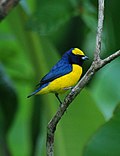| Image | Common name | Scientific name | Distribution |
|---|
 | Jamaican euphonia | Euphonia jamaica | Jamaica |
 | Orange-crowned euphonia | Euphonia saturata | Colombia, Ecuador, and Peru |
 | Plumbeous euphonia | Euphonia plumbea | Brazil, Colombia, French Guiana, Guyana, Peru, Suriname, and Venezuela. |
 | Purple-throated euphonia | Euphonia chlorotica | Argentina, Bolivia, Brazil, Colombia, Ecuador, French Guiana, Guyana, Paraguay, Peru, Suriname, Uruguay, and Venezuela. |
 | Finsch's euphonia | Euphonia finschi | Brazil, French Guiana, Guyana, Suriname and eastern Venezuela. |
 | Velvet-fronted euphonia | Euphonia concinna | Colombia |
 | Trinidad euphonia | Euphonia trinitatis | Colombia, Trinidad and Tobago, and Venezuela. |
 | West Mexican euphonia | Euphonia godmani | Mexico |
 | Scrub euphonia | Euphonia affinis | Belize, Guatemala, Honduras and Nicaragua and along the Atlantic coastal lowlands in Costa Rica. |
 | Yellow-crowned euphonia | Euphonia luteicapilla | Costa Rica, Nicaragua, and Panama |
 | White-lored euphonia | Euphonia chrysopasta | Bolivia, Brazil, Colombia, Ecuador, French Guiana, Guyana, Peru, Suriname, and Venezuela. |
 | White-vented euphonia | Euphonia minuta | southern Mexico south along the Pacific coast to northwestern Ecuador, the second across northern South America from the eastern Andean foothills as far east as the state of Pará in Brazil, and south to northern Bolivia. |
 | Green-chinned euphonia | Euphonia chalybea | northeastern Argentina, Brazil and Paraguay. |
 | Violaceous euphonia | Euphonia violacea | Trinidad, Tobago and eastern Venezuela south to Paraguay and northeastern Argentina. |
 | Yellow-throated euphonia | Euphonia hirundinacea | from Belize south to western Panama |
 | Thick-billed euphonia | Euphonia laniirostris | Bolivia, Brazil, Colombia, Costa Rica, Ecuador, Panama, Peru, and Venezuela. |
 | Spot-crowned euphonia | Euphonia imitans | Costa Rica and Panama. |
 | Olive-backed euphonia | Euphonia gouldi | southern Mexico to western Panama. |
 | Fulvous-vented euphonia | Euphonia fulvicrissa | Colombia |
 | Tawny-capped euphonia | Euphonia anneae | Colombia, Costa Rica, and Panama. |
 | Orange-bellied euphonia | Euphonia xanthogaster | Bolivia, Brazil, Colombia, Ecuador, Guyana, Panama, Peru, and Venezuela. |
 | Bronze-green euphonia | Euphonia mesochrysa | Bolivia, Colombia, Ecuador, and Peru. |
 | Golden-sided euphonia | Euphonia cayennensis | Brazil, French Guiana, Guyana, Suriname and eastern Venezuela. |
 | Rufous-bellied euphonia | Euphonia rufiventris | Bolivia, Brazil, Colombia, Ecuador, Peru, and Venezuela. |
 | Chestnut-bellied euphonia | Euphonia pectoralis | Argentina, Brazil, and Paraguay. |
|

























